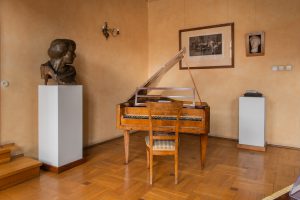Education at the Musical Instruments Museum in Poznań focuses mainly on presenting our unique national exhibition – many age groups take advantage of guided tours, during which you can not only learn what the exhibits presented are, but also find out what amazing stories are hidden behind them and listen to the sounds of selected musical instruments! During museum lessons, individual families of musical instruments are presented, and younger participants can even try their hand at playing some instruments. Music echoes here at every step!
A multimedia guide to the permanent exhibition of the Museum of Musical Instruments has been designed for individual guests, available at the price of the ticket for the tour. At present, it contains a 60-minute tour program covering selected topics from the entire exhibition. In addition to the basic information about the objects, the guide includes a brief historical sketch of the instrument, a description of the performance practice (all available in two language versions – Polish and English), sound examples, and photos of details and interesting details of the object.
Take a walk with a guide.
Guided Tour of the Exhibit (approx. 90 minutes)
A one-and-a-half-hour walk through all the rooms of the Musical Instrument Museum, during which stories will be illustrated with sound.
Themed Guided Tours (approx. 45 minutes)
- Top 10 Most Popular Instruments from the Musical Instrument Museum. Tales with Music in the Background.
- What the Comb Plays – A Story of Mechanical Instruments. A story of the least known family of musical instruments, including delicate barrel organs, loud carillons or mysterious pianolas. Accompanied by a presentation reaching back to ancient times and a complex construction, it will be accompanied by unheard of sounds of these instruments.
- Great composers and their instruments. What instruments did the musical genius Wolfgang Amadeus Mozart have and what was his inspiration? What did the court harpsichordist of Frederick II the Great – Carl Philipp Emanuel Bach, son of Johann Sebastian Bach – play on? And what role did the King of Prussia himself play in the music making? And what about the famous violin of Henryk Wieniawski? Many questions – dozens of stories embellished with music.
- The Piano of Chopin. Famous piano of Frederic Chopin. On what did the Polish virtuoso of the Romantic era play? What instruments were popular during his time? About this, and more, participants of the musical walk in the footsteps of Chopin will hear.
- Old bands and musical groups. What characterized old church bands? In the Venetian Basilica of St. Mark, two musical choirs were perfectly suited to the Venetian polychoral technique. In old Poland, music also resounded loudly and clearly. Among the most distinguished bands, one can mention the Poznań Collegium Musicorum or the Częstochowa Jasnogórska Band, whose composition and size were presented in the museum. The sounds of the old compositions and the instruments played in the bands will enhance the presented stories.
- The musical cultures of the world. In addition to the musical instruments we are familiar with every day, such as violins, pianos, and trumpets, there are many other interesting objects from different parts of the world. Do the instruments from Asia differ greatly from those from Africa? What bands were characteristic of a particular country? Visiting the top floor of the Musical Instrument Museum will be the best answer to these questions.
- Polish Folk Instruments. A story about our native instruments from different regions of Poland accompanied by musical examples.
COST
- A guided tour for 180 PLN (per group).
- Admission tickets for 1 PLN (per student).
- Two guardians of the group are admitted free of charge, additional people need to purchase tickets (10 PLN discounted, 15 PLN regular).
- Groups can have up to 25 people (including guardians). Larger groups are split into smaller ones. Every group is responsible for the tour guide fee.
REGISTRATION
- We accept reservations by email at o.olejniczak@mnp.art.pl
- with at least one week’s advance notice.
- The museum reserves the right to refuse orders in case of lack of available seats.
PRACTICAL INFORMATION
- Guided tours of the permanent exhibition and themed tours take place from Tuesday to Friday during the opening hours of the Museum for the public.
- Museum lessons are conducted exclusively on the basis of prior ordering. We accept applications by email at o.olejniczak@mnp.art.pl
Before placing your order please read our tour guide offerings.
- Students should bring their school ID cards.
- If you are unable to attend the previously booked tour, please inform us immediately.
- Please be punctual. Tours with groups arriving more than 15 minutes late may be shortened or canceled
- Teachers and guardians are responsible for the behavior of their wards during the visit to the Museum and, consequently, are obliged to be present during the tour with the guide.
- The Visiting Regulations for the MNP are in force during the tour.
BEFORE SCHOOL
Secrets of Musical Instruments
Through the presentation of live instruments, young participants will learn the secrets of various musical instrument families. In the second part of the session, the newly acquired knowledge will be tested during a march through selected museum halls.
In Chopin’s Parlor
A musical slice of life of Frederic Chopin. What instruments were popular during his time and what were his own preferences as a brilliant composer and pianist? The introduction, which will take place in the Museum’s exhibition, will include a presentation of instruments and musical examples, culminating in the design of a dream Chopin’s parlor.
PRIMARY SCHOOLS
Classes I-III
Secrets of Musical Instruments
By means of live instruments presented, the young participants of the classes will get to know the secrets of the various families of musical instruments. In the second part of the classes, the newly acquired knowledge will be tested by marching through the selected rooms of the Museum.
In Chopin’s Parlour
A musical excerpt from the life of Fryderyk Chopin. What instruments were popular in his time, and which ones did the outstanding composer and pianist prefer? An introduction taking place at the Museum’s exposition, during which instruments and musical examples will be presented, will lead to designing one’s own desired Chopin’s parlour.
Classes IV-VIII
Evolution of the Image of the Most Popular Musical Instruments
A story about the changes taking place over the years in the construction of the most popular musical instruments. History, creators and, most importantly, the music created by each instrument.
Amati’s Children – History of String Instruments
What were the first string instruments? Did violins always have four strings? How is the cello different from the double bass? We will answer these and many other questions during the classes, spiced up with string music.
In Chopin’s Parlour
A musical excerpt from the life of Fryderyk Chopin. What instruments were popular in his time, and which ones did the outstanding composer and pianist prefer? An introduction taking place at the Museum’s exposition, during which instruments and musical examples will be presented, will lead to designing one’s own desired Chopin’s parlour.
Trumpet, trombone… one clarinet. A Story about Wind Instruments
From the oldest primitive flutes made of bone to metal trumpets with a complicated valve system. The history of wind instruments contains many interesting examples and sounds, which we will explore during the classes.
SECONDARY SCHOOLS
Evolution of the image of the most famous musical instruments
A story of the changes that have taken place over the years in the construction of the most popular musical instruments. The history, creators, and most importantly, the music produced by each instrument.
Amati’s Children – A Story of Stringed Instruments
What were the first stringed instruments? Did violins always have four strings? What is the difference between a cello and a double bass? We will answer these and many other questions during this session, spiced up with some string music.
Trumpet, trombone… one clarinet. A story of wind instruments
From the oldest primitive flutes made of bone to metal trumpets with complex air flow mechanisms. The history of wind instruments contains many interesting examples and sounds, which we will explore during the session.
PRACTICAL INFORMATION
COST
- The lesson with the educator costs 85 PLN per group.
- The entrance tickets cost 1 PLN per student.
- Two supervisors of the group have free entry, additional people have to buy a ticket (10 PLN reduced price, 15 PLN normal price).
- The group can consist of up to 25 people (including supervisors). Larger groups are split into smaller ones and each group is charged for the museum lesson.
- Children up to 6 years old receive a free ticket at the ticket office.
REGISTRATION
- We accept reservations via email at o.olejniczak@mnp.art.pl
- with at least a one-week advance notice.
- The museum reserves the right to refuse orders in case of lack of available seats.
LESSON ORGANIZATION
- Museum lessons take place from Tuesday to Friday during Museum opening hours for the public.
- Museum lessons are conducted exclusively on the basis of prior order. Applications are accepted via email at o.olejniczak@mnp.art.pl.
Before placing an order, please familiarize yourself with the list of topics.
- The classes take place at the exhibits at the permanent and temporary exhibitions in the Museum.
- Students should bring their school ID.
- If you are unable to attend the previously booked lesson, please let us know immediately.
- We kindly ask you to observe punctuality. Group classes arriving more than 15 minutes late may be shortened or cancelled.
- Teachers and guardians are responsible for the behavior of their charges during a visit to the museum, and as such are obligated to be present for the museum lesson.
- The Visiting Regulations for the MNP are in force during the tour.






